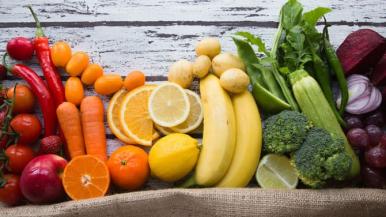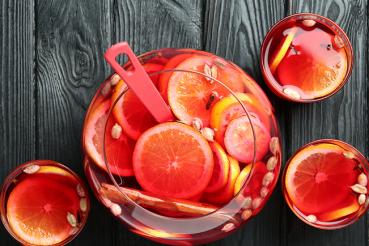If you're looking for a way to make your meals more vibrant, look no further than your grocery store's produce aisle. There, you'll find a rainbow of fruits and vegetables — from the palest white to the brightest orange to the deepest purple.
Fruits and vegetables get their coloration from phytochemicals, natural bioactive compounds which, in addition to giving many fruits and veggies their eye-catching hues, also promote good health.
In fact, the most vibrantly colored fruits and vegetables are the richest in vitamins, minerals, fiber and antioxidants.
Get your daily dose of fruits and vegetables
According to the food pyramid, you should be eating up to nine servings of vegetables and fruits each day.
Clinical dietitian Jennifer Ventrelle, MS, RD, LDN, recommends filling at least three-quarters of your plates at lunch and dinner with vegetables.
And instead of rich, sugary treats after your meals or for between-meal snacks, use whole fresh fruits to satisfy your sweet tooth.
What do the colors mean?
But which veggies and fruits you eat is as important as how often you eat them. That's because different colors have different health benefits:
- Red fruits and vegetables, such as tomatoes, strawberries and red beans, are packed with vitamin C, vitamin A, potassium and antioxidants.
- Yellow/orange fruits and vegetables, including carrots, peaches, squash and pineapple, are also loaded with vitamin C, vitamin A and potassium. They can also boost the immune system and enhance vision.
- Mushrooms, bananas, onions and other white fruits and vegetables are good for the heart and help to control cholesterol levels.
- Green means lots of heart-protective potassium and vitamin K, which aids the blood clotting process. Green fruits and veggies also help to maintain vision health and strong bones and teeth. Dark green, leafy vegetables have the highest concentration of antioxidants and fiber.
- Blue/purple fruits and vegetables, including such favorites as cranberries, purple grapes, raisins and eggplant, boost urinary tract health and memory function and promote healthy aging.
"As often as possible, choose fruits and vegetables that are high in fiber," says Ventrelle. "They will fill you up more, leaving less room for foods that are high in calories and fat."
An added benefit: High-fiber diets have been associated with decreased risk and recurrence of cancer.
Ventrelle also recommends eating fruits and vegetables that are highest in antioxidants, which boost the body's immune system, protect blood cells from free radicals, promote the growth of healthy cells and may help to lower the risk of stroke.
Fresh is best, but if you do cook vegetables, use a lighter preparation. Don't use a lot of oil, or fry or sauté them. Steaming or grilling is better.
Fruit and veggie do's and don'ts
Here are a few other things to keep in mind when planning your menu:
- Although fruits and vegetables are healthy, they aren't necessarily low in calories. "Avocado is a good type of fat," Ventrelle says, "but one-fourth of an avocado has 100 calories." Raisins and cherries are other examples of fruits that, while healthful, are high in calories. Eat higher-calorie fruits and veggies in moderation.
- Go light on the starchy vegetables. If you choose sweet potatoes as a side dish, use that as your starch even though it's technically a vegetable. Don't have sweet potatoes and corn, which is also a starch. Pick some other veggie that's higher in fiber.
- Veggie preparation matters. "Fresh is best, but if you do cook vegetables, use a lighter preparation," Ventrelle says. "Don’t use a lot of oil, or fry or sauté them. Steaming or grilling is better." And be aware that if you boil vegetables, you lose a lot of the health benefits. The nutrients leach out. So when you pour out the water, you're also pouring out the nutrients.
- Don't drown fruits and veggies in heavy sauces, dips or toppings, especially if you're watching your weight. Try sprinkling apple slices with cinnamon instead of smothering them with peanut butter or caramel. And dunk those carrot sticks in fat-free yogurt instead of ranch dip. If you must have sauces or dips, look for lighter recipes or limit the amount you eat to a few tablespoons.
- Eat with the seasons. Choose fresh fruits and vegetables that are "in season" to ensure you're eating a good variety of colors throughout the year. For instance, add squashes, root vegetables and different types of apples to your fall menu.
- If you can't get fresh fruits and veggies, frozen is fine. Avoid eating a lot of canned vegetables, because they tend to have more sodium. And choose canned fruit that's packed in water or natural juice, not sugary syrup.
- If you like dried fruits, eat them in moderation. They tend to have a higher concentration of calories and sugar than their fresh counterparts. A serving size of dried fruit should be no more than one-fourth of a cup.
- If you're counting calories, buy smaller pieces of fruit. Large bananas can be almost 200 calories, so pick smaller ones. Apples, nectarines, peaches and other round fruits should be roughly the size of a tennis ball. For bite-sized fruits, such as grapes and cherries, one serving equals approximately 17 pieces.
With so many vegetables and fruits to choose from, and with so many ways to enjoy them, you'll find it's easy to create a "colorful" diet that’s satisfying, nutritious and delicious.




